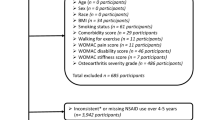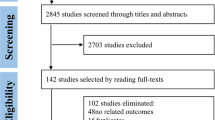Abstract
Disease models of osteoarthritis (OA) have shown that COX-2-selective nonsteroidal anti-inflammatory drugs (NSAIDs, coxibs) may have beneficial effects on cartilage. Clinical or epidemiological evidence for this potential association is scarce. The objective of this study was to evaluate the risk of hip or knee replacement in users of coxibs compared to nonselective NSAIDs. A population-based case–control study was conducted with the Dutch PHARMO Record Linkage System. Cases (n = 26,202) had a first replacement of the hip or knee after enrollment (2000–2009). Up to two controls (without hip or knee replacement) were matched by year of birth, gender, healthcare region, and calendar year. Using conditional logistic regression analysis, odds ratios (ORs) for hip or knee replacement were estimated by comparing long-term (≥1 year) nonselective NSAID use with long-term coxib use. Analyses were statistically adjusted for disease and drug history. Long-term use of nonselective NSAIDs was not associated with a different risk of hip replacement (adjusted OR = 0.89, 95 % CI 0.65–1.22) or knee replacement (adjusted OR = 0.74, 95 % CI 0.49–1.11) as compared to long-term coxib use. Results were not different after stratification by gender, age, and cardiovascular or gastrointestinal disease. This study shows that long-term users of nonselective NSAIDs do not have a different risk of hip or knee replacement as compared to long-term coxib users. Therefore, our results do not support that patients with OA could benefit from using coxibs in order to slow progression of this disease.


Similar content being viewed by others
References
Bijlsma JWJ, Berenbaum F, Lafeber FPJG (2011) Osteoarthritis: an update with relevance for clinical practice. Lancet 377:2115–2126
Zhang W, Nuki G, Moskowitz RW, Abramson S, Altman RD, Arden NK et al (2010) OARSI recommendations for the management of hip and knee osteoarthritis: part III. Changes in evidence following systematic cumulative update of research published through January 2009. Osteoarthritis Cartilage 18:476–499
Verbruggen G (2006) Chondroprotective drugs in degenerative joint diseases. Rheumatology 45:129–138
Zweers MC, de Boer TN, van Roon JAG, Bijlsma JWJ, Lafeber FPJG, Mastbergen SC (2011) Celecoxib: considerations regarding its potential disease-modifying properties in osteoarthritis. Arthritis Res Ther 13:239
El Hajjaji H, Marcelis A, Devogelaer JP, Manicourt DH (2003) Celecoxib has a positive effect on the overall metabolism of hyaluronan and proteoglycans in human osteoarthritic cartilage. J Rheumatol 30:2444–2451
Mastbergen SC, Bijlsma JW, Lafeber FP (2005) Selective COX-2 inhibition is favorable to human early and late stage osteoarthritic cartilage: a human in vitro study. Osteoarthritis Cartilage 13:519–526
Mastbergen SC, Jansen NW, Bijlsma JW, Lafeber FP (2006) Differential direct effects of cyclo-oxygenase-1/2 inhibition on proteoglycan turnover of human osteoarthritic cartilage: an in vitro study. Arthritis Res Ther 8:R2
Blot L, Marcelis A, Devogelaer JP, Manicourt DH (2000) Effects of diclofenac, aceclofenac and meloxicam on the metabolism of proteoglycans and hyaluronan in osteoarthritic human cartilage. Br J Pharmacol 131:1413–1421
Mastbergen SC, Marijnissen AC, Vianen ME, Zoer B, Roermund PM, Bijlsma JW, Lafeber FP (2006) Inhibition of COX-2 by celecoxib in the canine groove model of osteoarthritis. Rheumatology 45:405–413
Fukai A, Kamekura S, Chikazu D, Nakagawa T, Hirata M, Saito T et al (2012) Lack of chondroprotective effect of cyclooxygenase-2 inhibition in a mouse surgical osteoarthritis model. Arthritis Rheum 64:198–203
de Boer TN, Huisman AM, Polak AA, Niehoff AG, van Rinsum AC, Saris D et al (2009) The chondroprotective effect of selective COX-2 inhibition in osteoarthritis: ex vivo evaluation of human cartilage tissue after in vivo treatment. Osteoarthritis Cartilage 17:482–488
de Boer TN, Mastbergen SC, Huisman AM, Polak AA, Bijlsma JW, Lafeber FP (2010) Lack of disease modifying activity of celecoxib in end-stage OA: a randomized controlled trial. Osteoarthritis Cartilage 18(Suppl 2):S145
Tindall EA, Sharp JT, Burr A, Katz TK, Wallemark CB, Verburg K et al (2002) A 12-month, multicenter, prospective, open-label trial of radiographic analysis of disease progression in osteoarthritis of the knee or hip in patients receiving celecoxib. Clin Ther 24:2051–2063
Sawitzke AD, Shi H, Finco MF, Dunlop DD, Bingham CO 3rd, Harris CL et al (2008) The effect of glucosamine and/or chondroitin sulfate on the progression of knee osteoarthritis: a report from the glucosamine/chondroitin arthritis intervention trial. Arthritis Rheum 58:3183–3191
Raynauld JP, Martel-Pelletier J, Beaulieu A, Bessette L, Morin F, Choquette D et al (2010) An open-label pilot study evaluating by magnetic resonance imaging the potential for a disease-modifying effect of celecoxib compared to a modelized historical control cohort in the treatment of knee osteoarthritis. Semin Arthritis Rheum 40:185–192
Ding C, Cicuttini F, Jones G (2009) Do NSAIDs affect longitudinal changes in knee cartilage volume and knee cartilage defects in older adults? Am J Med 122:836–842
Reijman M, Bierma-Zeinstra SM, Pols HA, Koes BW, Stricker BH, Hazes JM (2005) Is there an association between the use of different types of nonsteroidal anti-inflammatory drugs and radiologic progression of osteoarthritis? The Rotterdam Study. Arthritis Rheum 52:3137–3142
Rashad S, Revell P, Hemingway A, Low F, Rainsford K, Walker F (1989) Effect of non-steroidal anti-inflammatory drugs on the course of osteoarthritis. Lancet 2:519–522
Herings RMC (2007) The PHARMO System. CNS Spectr 12:9 Suppl 16:14–17. http://www.primarypsychiatry.com/aspx/articledetail.aspx?articleid=1826. Accessed on 6 Aug 2012
de Vries F, Pouwels S, Bracke M, Lammers JW, Leufkens H, Klungel O et al (2008) Use of inhaled corticosteroids and the risk of non-fatal acute myocardial infarction. J Hypertens 26:124–129
Arbouw ME, Movig KL, van Staa TP, Egberts AC, Souverein PC, de Vries F (2011) Dopaminergic drugs and the risk of hip or femur fracture: a population-based case-control study. Osteoporos Int 22:2197–2204
de Vries F, Pouwels S, Bracke M, Lammers JW, Klungel O, Leufkens H et al (2008) Use of beta2 agonists and risk of acute myocardial infarction in patients with hypertension. Br J Clin Pharmacol 65:580–586
Pouwels S, Lalmohamed A, van Staa T, Cooper C, Souverein P, Leufkens HG et al (2010) Use of organic nitrates and the risk of hip fracture: a population-based case-control study. J Clin Endocrinol Metab 95:1924–1931
Pouwels S, Lalmohamed A, Souverein P, Cooper C, Veldt BJ, Leufkens HG et al (2011) Use of proton pump inhibitors and risk of hip/femur fracture: a population-based case-control study. Osteoporos Int 22:903–910
van den Brand MW, Pouwels S, Samson MM, van Staa TP, Thio B, Cooper C et al (2009) Use of anti-depressants and the risk of fracture of the hip or femur. Osteoporos Int 20:1705–1713
SAS/STAT 9.2 user’s guide, 2nd ed. Example 64.5 Conditional logistic regression for m:n matching. http://support.sas.com/documentation/cdl/en/statug/63033/HTML/default/viewer.htm#statug_phreg_sect036.htm. Accessed on 9 Aug 2012
Greenland S (1995) Dose–response and trend analysis in epidemiology: alternatives to categorical analysis. Epidemiology 6:356–365
Pouwels S, Lalmohamed A, Leufkens B, de Boer A, Cooper C, van Staa T et al (2009) Risk of hip/femur fracture after stroke: a population-based case-control study. Stroke 40:3281–3285
Rolfson O, Kärrholm J, Dahlberg LE, Garellick G (2011) Patient-reported outcomes in the Swedish Hip Arthroplasty Register—results of a nationwide prospective observational study. J Bone Joint Surg Br 93:867–875
Conaghan PG, Hunter DJ, Maillefert JF, Reichmann WM, Losina E (2011) Summary and recommendations of the OARSI FDA Osteoarthritis Assessment of Structural Change Working Group. Osteoarthritis Cartilage 19:606–610
Alvarez-Soria MA, Largo R, Santillana J, Sanchez-Pernaute O, Colvo E, Hernandez M et al (2006) Long term NSAID treatment inhibits COX-2 synthesis in the knee synovial membrane of patients with osteoarthritis: differential proinflammatory cytokine profile between celecoxib and aceclofenac. Ann Rheum Dis 65:998–1005
Alvarez-Soria MA, Herrero-Beaumont G, Moreno-Rubio J, Calvo E, Santillana J, Egido J et al (2008) Long-term NSAID treatment directly decreases COX-2 and mPGES-1 production in the articular cartilage of patients with osteoarthritis. Osteoarthritis Cartilage 16:1484–1493
Hardy MM, Seibert K, Manning PT, Currie MG, Woerner BM, Edwards D et al (2002) Cyclooxygenase 2-dependent prostaglandin E2 modulates cartilage proteoglycan degradation in human osteoarthritis explants. Arthritis Rheum 46:1789–1803
Petri H, Urquhart J (1991) Channeling bias in the interpretation of drug effects. Stat Med 10:577–581
MacDonald TM, Pettitt D, Lee FH, Schwartz JS (2003) Channelling of patients taking NSAIDs or cyclooxygenase-2-specific inhibitors and its effect on interpretation of outcomes. Rheumatology 42:3–10
Zhao SZ, Wentworth C, Burke TA, Makuch RW (2004) Drug switching patterns among patients with rheumatoid arthritis and osteoarthritis using COX-2 specific inhibitors and non-specific NSAIDs. Pharmacoepidemiol Drug Saf 13:277–287
van der Schee E, van Dijk L, Blom L, Lelie-van der Zande R, Broerse A (2004) Medicatiebewaking rond recept—en zelfzorggeneesmiddelen. Consumentenpanel Gezondheidszorg peilt leemtes. Pharm Weekbl 139:618–622
Pedersen AB, Sorensen HT, Mehnert F, Overgaard S, Johnsen SP (2010) Risk factors for venous thromboembolism in patients undergoing total hip replacement and receiving routine thromboprophylaxis. J Bone Joint Surg Am 92:2156–2164
National Joint Registry for England and Wales (2011) NJR 8th annual report. www.njrcentre.org.uk. Accessed on 25 July 2012
Acknowledgments
The Department of Pharmacoepidemiology and Clinical Pharmacology, Utrecht Institute for Pharmaceutical Sciences, has received unrestricted research funding from the Netherlands Organisation for Health Research and Development (ZonMW), the Dutch Health Care Insurance Board (CVZ), the Royal Dutch Pharmacists Association (KNMP), the privately–publicly funded Top Institute Pharma (www.tipharma.nl, includes cofunding from universities, government, and industry), the EU Innovative Medicines Initiative (IMI), the EU 7th Framework Program (FP7), the Dutch Medicines Evaluation Board, and the Dutch Ministry of Health and Industry (including GlaxoSmithKline, Pfizer, and others).
Conflict of interest
The authors have stated that they have no conflict of interest.
Author information
Authors and Affiliations
Corresponding author
Rights and permissions
About this article
Cite this article
Klop, C., de Vries, F., Lalmohamed, A. et al. COX-2-Selective NSAIDs and Risk of Hip or Knee Replacements: A Population-Based Case–Control Study. Calcif Tissue Int 91, 387–394 (2012). https://doi.org/10.1007/s00223-012-9646-x
Received:
Accepted:
Published:
Issue Date:
DOI: https://doi.org/10.1007/s00223-012-9646-x




